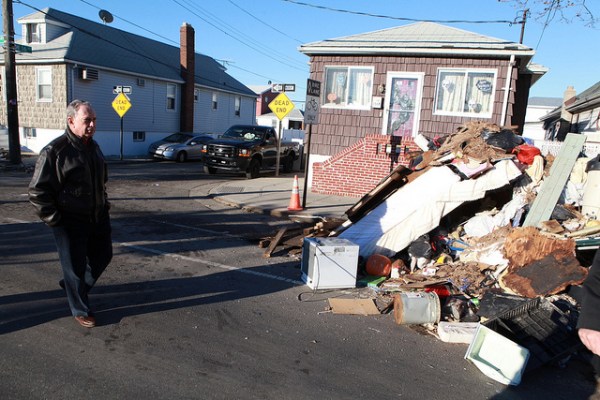
A storm from the tropics blew through town last week. It left wintry weather in its wake, along with a path of destruction that has left as many as 40,000 New Yorkers temporarily homeless. Half of them are expected to be unable to go home for weeks or months, assuming they even have homes to return to. Serious damage to heat and electrical infrastructure in apartment buildings and homes on the waterfront are among the most serious issues that have created a housing crisis for the city following Hurricane Sandy.
“Many of the fears we have is that with cold weather coming, we have to make sure people can stay warm,” Mayor Bloomberg said at an afternoon press briefing. “Among the hardest hit are the Rockaways and Staten Island. A lot of places aren’t gonna have electricity but are going to experience the cold. That is the next big problem for us.”
At a separate briefing with the mayor and FEMA this morning, Governor Cuomo echoed the Bloomberg administration’s concerns. “People don’t like to leave their homes, but the reality is going to be in the temperature, and then we are going to have tens of thousands of people who need housing solutions right away, and a variety of housing solutions,” the governor said. He added that a morning meeting with local, state and federal officials was mostly spent figuring out ways to house those in need for weeks or even months.
Temperatures are expected to fall to 37 degrees tonight in the city, with a high in the mid-40s tomorrow and a low in the mid- to low-30s tomorrow night. Areas on the
The mayor said that once power is restored by the various utilities, from Con Ed to the Long Island Power Authority, which provides electricity to the hard-hit Rockaways, many people will be able to return home to their houses and apartments with heat and light, bringing down the estimated evacuation count from 40,000 to about 20,000. But many buildings, even once power is back, will not be operational because of damage to their internal utilities from the storm surge.
“Over the past few days, we have been going block by block to identify the issues blocking many of them from getting the power back on,” the mayor said. “We’re resolving many of the issues one block and even one house at a time. Even when some of the power is turned back on, the buildings are going to be out of commission for a long time because of damage to their boilers and electrical systems.”
Both the mayor and the governor are stressing that people without power should go to one of the city’s 15 shelters for protection from the elements. The city has also set up warming centers to help combat the conditions. “If you find yourself shivering uncontrollably or see someone who is disoriented, those are signs of hypothermia,” the mayor said. “You really should get to a warm place, covered with blankets, a hot
A big issue has been for public housing residents, whose buildings are aging and have fragile infrastructure. “Some 45,000 public housing residents live in the coastal areas designated as Zone A, many of them in the Rockaways,” the mayor said.
The desperation of the situation was underscored by FEMA director Craig Fugate, who made it clear that many more New Yorkers have been seriously effected besides those currently without reliable shelter. “Our administration numbers give you some sense of the magnitude, but right now, as of this morning, we have 86,000 households have registered for assistance already directly deposited into those accounts is $96 million,” Mr. Fugate said.
Those numbers are only expected to rise in the coming weeks as people get power back and lives return to enough normality that more claims can be filed.
“We don’t have a lot of empty housing in the city, so it’s hard to find it when we need it,” Mayor Bloomberg said during the closing remarks of his afternoon press briefing.

